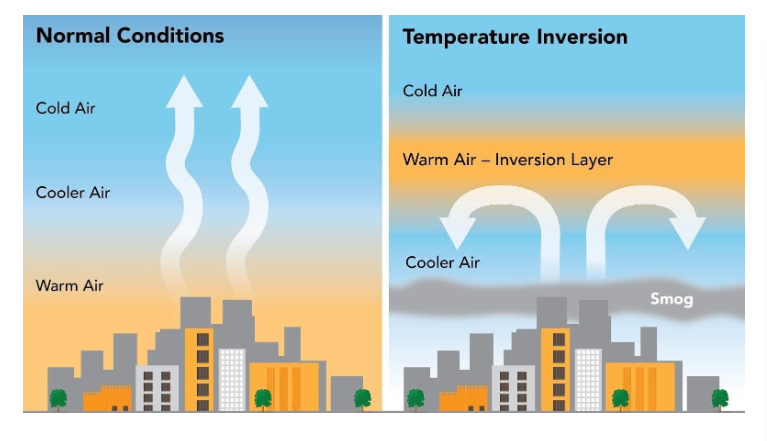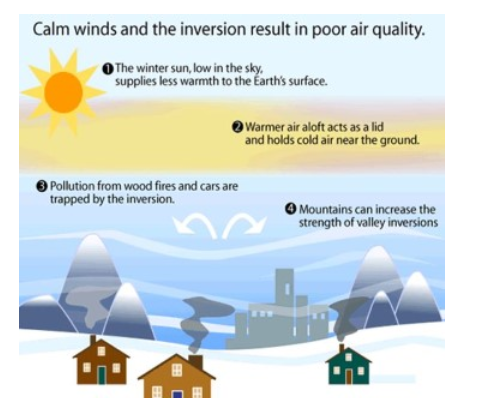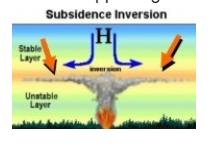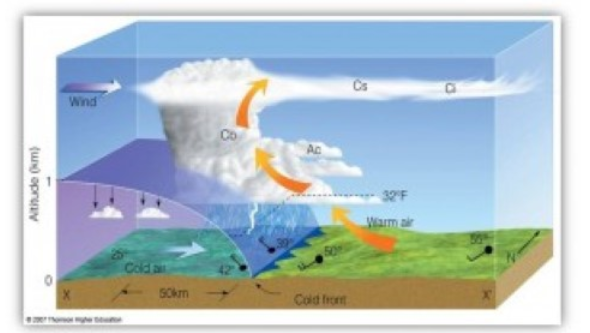Thermal inversion refers to a distinct phenomenon occurring within the troposphere, where the temperature shows an unusual pattern by reversing the typical thermal gradient.
- Typically, the troposphere's temperature decreases with altitude due to its proximity to the Earth's surface.
- However, in a thermal inversion, the standard temperature gradient is inverted, resulting in a layer of warm air lying above a layer of cooler air close to the surface.
- This inversion can impede vertical convection currents, as the warmer air above prevents the cooler air below from rising.
- Thermal inversions can occur due to various factors such as clear, calm nights, geographical features, and human activities like industrial processes or urban areas.
- The presence of thermal inversions often causes the accumulation of pollutants, as the warmer air traps the cooler air beneath it, preventing the dispersion of contaminants. This situation can significantly impact air quality and result in adverse health effects.

CONDITION FOR TEMPERATURE INVERSION
- The conditions — long nights, clear skies, and stable air — contribute to a situation in which the outgoing radiation exceeds the incoming radiation.
- This leads to radiational cooling, particularly at the surface of the Earth.
- During these periods, when the sky is clear and there's little air movement to mix the atmosphere vertically, heat loss from the Earth's surface is pronounced, creating conditions where surface temperatures can drop significantly.
TYPES OF TEMPERATURE INVERSION
INTERMONTANE VALLEY INVERSION
- Temperature inversion refers to a reversal of the normal distribution of temperature in the atmosphere.
- This phenomenon occurs when a sloping surface, such as a mountainside or valley, leads to the cooling of the lower layers of air more rapidly than the upper layers.
- As a result, the colder, condensed air near the ground settles down, creating a layer of cold air, while the upper layers remain relatively warmer.
- This inversion in the typical vertical temperature distribution is a significant feature in middle and higher latitudes, particularly prevalent in regions with elevated terrains such as high mountains or deep valleys.

GROUND INVERSION
Ground inversion is a common occurrence when the air cools upon contact with a colder surface, ultimately becoming cooler than the air above it.
- This phenomenon often emerges on clear nights, as the ground rapidly cools due to radiation.
- In some instances, if the temperature of the surface air decreases below its dew point, it may lead to the formation of fog.
- This type of temperature inversion is prevalent in higher latitudes.
- Moreover, in lower and middle latitudes, surface temperature inversions typically occur on cold nights and dissipate during daytime.

SUBSIDENCE INVERSION
Subsidence inversion occurs when a widespread layer of air descends, creating compression and heating due to the increased atmospheric pressure.
- This compression leads to a reduction in the lapse rate of temperature.
- If the descending air mass sinks low enough, the result can be warmer air at higher altitudes compared to lower altitudes, thereby forming a temperature inversion.
- Subsidence inversions are typical over the northern continents in winter (due to a dry atmosphere) and over subtropical oceans, mainly because these regions experience subsiding air as they are situated under substantial high-pressure centres.
- This type of temperature inversion is referred to as an upper surface temperature inversion since it occurs in the upper regions of the atmosphere.

FRONTAL INVERSION
Frontal inversion takes place when a cold air mass displaces a warm air mass (commonly known as Cold and Warm Fronts), and the cold air mass lifts the warm air mass aloft.
- Consequently, the front between the two air masses is characterised by having warm air positioned above cold air.
- This type of inversion has a considerable slope, unlike other inversions that tend to be more horizontal in nature.
- Frontal inversions might feature higher humidity levels, often accompanied by the presence of clouds directly above the inversion layer.
- This type of inversion is typically unstable and can be disrupted by weather changes.

FAQs related to temperature inversion
1. What is a temperature inversion?
Ans. A temperature inversion refers to an atmospheric condition where the normal lapse rate of temperature (decreasing with altitude) is reversed, causing warmer air to overlay cooler air at lower levels.
2. What causes temperature inversion?
Ans. Various factors cause temperature inversions, including cooling of the ground on clear nights, sinking air masses compressing and heating, or colder air undercutting warmer air along a frontal boundary.
3. How does temperature inversion impact air pollution?
Ans. Temperature inversions trap pollutants close to the ground, preventing their dispersion. This often results in the accumulation of smog, fog, or haze, leading to poor air quality.
4. What are the types of temperature inversions?
Ans. Common types include ground inversions (related to nocturnal cooling), subsidence inversions (due to descending air masses), frontal inversions (formed at the boundaries of air masses), and radiation inversions (primarily occurring overnight).
5. Where are temperature inversions frequently observed?
Ans. They're commonly observed in valleys, cities, and regions prone to air stagnation. Mountainous regions and places with consistent anticyclones might also experience inversions.
6. What are the implications of a temperature inversion on weather patterns?
Ans. Inversions can lead to stable weather conditions, especially during high-pressure systems, and can prevent vertical mixing of air, hindering cloud formation and precipitation.
7. How are temperature inversions important in aviation?
Ans. Pilots need to be aware of inversions as they can affect visibility, especially in cases of fog and low-level clouds, impacting take-off and landing conditions.
8. How do temperature inversions influence agriculture?
Ans. Temperature inversions can pose risks to crops by causing frost damage due to the trapping of cold air near the ground, particularly during the night.
9. How do temperature inversions affect outdoor activities?
Ans. Inversions can influence outdoor activities, particularly in terms of air quality. People with respiratory conditions may experience worsened symptoms due to poor air quality during inversions.
10. Can temperature inversions be forecasted?
Ans. Meteorologists and weather experts forecast inversions using weather models, considering atmospheric conditions, air masses, and topography to predict their occurrence

